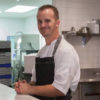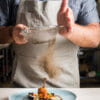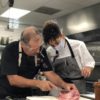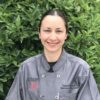Baking and Pastry School: Read This Before You Enroll

Do you dream of going to baking and pastry school as the first step towards opening your own business? Let’s look at what it takes to make this dream a reality.
For these and other answers I turned to the pros for help. Chef Briana Bielucke is a pastry chef and director of education, and Chef Natalie Galvan is a professional pastry chef and instructor, both at Culinary Lab Cooking School in Tustin, California.
What is the Difference Between Culinary Arts and Baking & Pastry?
Both are performed inside a kitchen and everybody wears a chef coat, but the similarities between culinary arts and baking & pastry sort of end there.
Culinary arts centers include the cooking of meats, vegetables, and seafood for appetizers and main dishes to be served in a restaurant.
Baking and pastry school deals with baking bread, cakes, pies, cookies and candies for a dessert menu.
So, it might be just a personal preference. Do you like cooking meat, or are you more attracted to the science of a souffle?
In a school setting, culinary arts trains you on things like meal prep, cooking techniques, kitchen etiquette, proper training on the equipment and teamwork. The recipe is secondary.
Baking and pastry school, on the other hand, is more about precise measurements, attention to detail and the individual’s artistry. Bakers and pastry chefs would never “wing it,” as is commonplace with cooks. Pastry chefs follow a recipe exactly how it’s written. Their true artistic talents come through in the presentation.
Chef Briana Bielucke was drawn to pastry because of the science associated with it. “A lot of cooks say they hate baking because it is too scientific and precise,” she said. “I feel the opposite. Because it is so precise that if you follow the proper techniques and procedures and the formula exactly, the odds of you achieving good results are very high.”
What Skills Does a Pastry Chef Need?
A pastry chef (as opposed to a baker) is the person who generally runs a pastry department. In larger kitchens, he or she is responsible for overseeing the pastry team and conducting administrative duties within the kitchen.
A background in management: He or she is responsible for managing the pastry department or bakery staff. The pastry chef also is responsible for inventory, making sure the equipment is in proper condition and ingredients are stocked, fresh, and ready to use.
Creative: Pastry chefs must exhibit a high level of creativity and artistic ability due to the fine detail that goes into their craft.
Precise and organized: A pastry chef may be responsible for creating recipes, usually from scratch. He or she needs to provide detailed instructions on measurements and processes.
Patient: A pastry chef is also a teacher. Learning how to create complex presentation desserts is difficult and takes years to perfect, so pastry chefs have to show patience with their staff and customers.
Chef Galvan says patience is also tested while on-the-job. “Guests don’t always get dessert first, so we wait our turn in service and we can’t rush our product. Especially with bread. We don’t tell the dough when it’s ready, it tells us,” she said.
What is the Difference Between a Baker and Pastry Chef?
“A pastry chef is usually the person in charge of the pastry department or bakery, and a baker is traditionally not in charge of a team,” explains Chef Bielucke.
“A baker can work in different areas of a bakery. They could bake bread or do the production. There are also different areas a pastry chef or baker can specialize in, such as a chocolate chair, cake decorator, confectioner and so on.”
Do I Need to go to Baking and Pastry School to Become a Pastry Chef?
Although it is not a requirement to become a professional pastry chef, most chefs do complete some sort of formal training before running a bakery or a pastry department.
Baking and pastry school does not make someone qualified to be a pastry chef. It provides foundational skills that help them get started in a bakery or pastry kitchen and grow more quickly through the ranks.
There are several avenues, such as online courses, community colleges, technical schools and four-year universities for achieving a certificate or degree. All take a different approach to prepare students for a career as a pastry chef and come with pros and cons.
Online Courses
A bakery and pastry school that is offered online teaches strictly through the use of videos, with students practicing techniques at home and usually submitting videos or pictures for feedback.
These programs offer busy students the flexibility of completing classwork on their schedule, usually at a more affordable price than traditional baking and pastry programs. The downside, of course, is that instead of learning hands-on with a chef instructor in a commercial kitchen, students work alone in a home kitchen.
Community Colleges
A baking and pastry school offered through a community college can be a great option for the budget-minded student, as tuition prices are generally quite a bit lower than at technical schools or university programs. Even online programs can cost more.
There are very good community college pastry arts programs around the country offering degree and certificate programs. These programs often take two years or more to complete and may require students to take general education and other non-pastry courses.
Because of the low price point, community college classes are often large and difficult to get into. However, for the patient student, they can be a great way to get started.
Technical schools
Technical baking and pastry schools are typically seen as the faster way to get into the baking and pastry industry, offering courses as short as six to 12 months. Tuition is usually quite a bit more than a community college, but less than a university.
Programming is focused primarily on baking and pastry skills without much in the way of general education requirements.
If you can afford them, these schools can be an effective way to get started quickly on a career in a pastry kitchen. Some technical schools have come under fire in recent years for not delivering value consistent with tuition costs, or for over-promising and under-delivering. Still, there are great technical programs out there.
Hybrid Schools
A hybrid baking and pastry school, such as CulinaryLab in Tustin, California, combine the teachings of a technical school with a 1,000-hour apprenticeship. Students attend school while concurrently working in a local bakery or pastry kitchen.
Degree programs and universities: offer four years of hands-on training from top-notch instructors in realistic restaurant simulation. It’s the closest thing to working in an actual restaurant, and the instruction focuses more on training than immediate results like in a professional kitchen.
The pros are that the students will leave a university as prepared as they can be for a job in a professional kitchen. The cons, however, can’t be overlooked.
Students are often left in serious financial debt, possibly racking up $45,000-$100,000 of debt for their education. And often executive chefs say they don’t put great value in a culinary education when hiring new cooks. Chefs often prefer to mold their young apprentices themselves. Most cooks start at the bottom, including those with a degree from an expensive university.
What Career Paths Are Available to Pastry Chefs?
As a trained pastry cook entering the workforce, you’ll have a world of options to choose from. Your first decision will likely be to select what kind of environment you’d like to work in, from high-end restaurants, bakeries, hotels, stadiums, and catering.
As with most food-service and hospitality-related jobs, don’t expect to get rich. No matter which school you went to, you’ll start from the bottom and work your way up.
According to the U.S. Bureau of Labor Statistics (BLS), the median salary for bakers was $26,520 per year in 2018 with job opportunities projected to increase by about 8 percent in the decade-spanning 2016-2026. For pastry chefs, the median salary in 2019 was $44,077 with an 11 percent projected job growth rate over the next 10 years.
Jobs in the industry are usually pretty easy to come by, due to high turnover rates and the constant need for skilled workers.
“The beautiful thing about being a pastry chef is the many different routes we can take in our career,” Chef Galvin said. “We have chocolatiers, artisan bread bakers, cake decorators, restaurant pastry chefs, confectionaries, ice cream makers, research and development to name a few. Each one is so different from the other but we all fall under the category of pastry chefs.”
What are the Pros and Cons of Being a Pastry Chef?
Chef Bielucke puts it simply like this: “Pros? You’re surrounded by delicious pastries every day. Cons? You’re surrounded by delicious pastries every day.”
Most people don’t enter a career in the food-service industry for the money. It usually has more to do with a passion for cooking and baking, and the joy out of creating something that others will enjoy and pay good money to eat.
“Working in a kitchen can be extremely physical and tiring,” Chef Bielucke said. “But most chefs find the thought of sitting at a desk from 9 to 5 soul-crushing. It takes a certain type of person that enjoys working long hours on their feet in intense, high-pressure environments. But we do it, and could not imagine ourselves doing anything else.”
What Will I Learn in a Baking and Pastry Apprenticeship?
Many cooking schools offer an apprenticeship program to its students. CulinaryLab is one of those schools where the training is not limited to the classroom.
An apprenticeship offers students a chance to enter the workforce while still attending school for additional training to learn their craft in a real restaurant while also getting paid. Apprenticeships can last one to four years, after which the student can use that valuable experience to move on to another job in the industry or even stay on as a permanent employee.
School administrators work with known restaurants in the region to recommend aspiring chefs for employment and keep close tabs on their progress once placed. It’s a symbiotic relationship that benefits the students, the school and the restaurants alike.
“Those kitchens are viewed as an extension of the classroom,” Chef Bielucke said. “Students will get the opportunity to learn from a reputable chef. As well as work in various areas of the kitchen. No student will ever be just peeling apples or cracking eggs all day.”
How do I Choose the Right Baking and Pastry School?
Before choosing a baking and pastry school you should first decide what kind of job you envision yourself working in when school is done. How much money do you want to make? What level of leadership do you aspire to reach and how much time can you take to get there?
Aside from these goal-oriented questions, you need to figure how location and personal finances will play into your tough decision.
These metrics will help guide you toward finding the best culinary option out there for you.
For many of you, these are the basic questions you will need to answer when choosing the right pastry school:
How far can I travel or relocate for school? Is there a local junior college or certificate program nearby?
How much schooling can I afford? Is it better to enroll in a $100,000 bachelor’s degree program at a college or university or take night classes at a community college or culinary institute?
When am I available? Are you trying to fit your culinary education around a day job or do you have full-time hours available during the week?
How long do you want to be in school? Some certificate programs can be fast-tracked over a six-month period. Other, more detailed programs can take two or even four years as part of an academic regimen.
What are your plans for after school? If your dream is restaurant management or hospitality executive you might lean toward a four-year bachelor’s degree.
But if you prefer to start as a baker or pastry chef right out of school, you might prefer programs that work hard to place you in a job or apprenticeship during your education.
“I always recommend to students that they shop around and look at other different culinary schools,” Chef Bielucke of CulinaryLab said. “Some of the many reasons students tell me they chose CulinaryLab is because we are not like big traditional schools. We have a 16-to-1 student-teacher ratio so students feel they get lots of guidance from their instructor.
Some culinary schools have students sit in lecture rooms for an entire day then cook on the second. Our students are cooking all day every day. Because we’re small, our staff is also able to support each student throughout their culinary journey.”
Whatever your choice, whether your goal is creating mouth-watering desserts or elaborate wedding cakes, if you have the passion, skill, proper techniques and a good work ethic, you can be successful in the business.
Contact us today if you are ready to start your journey towards completing baking and pastry school.










